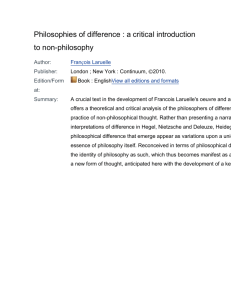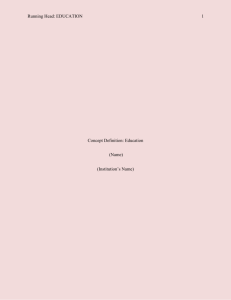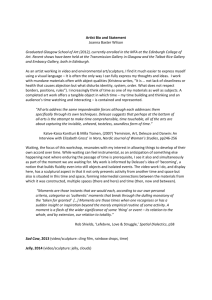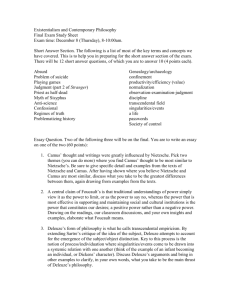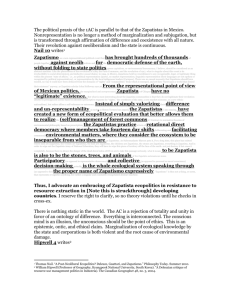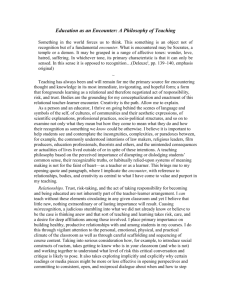GEOTRAUMATIC EVACUATION OF THE VOICE Miguel Prado
advertisement
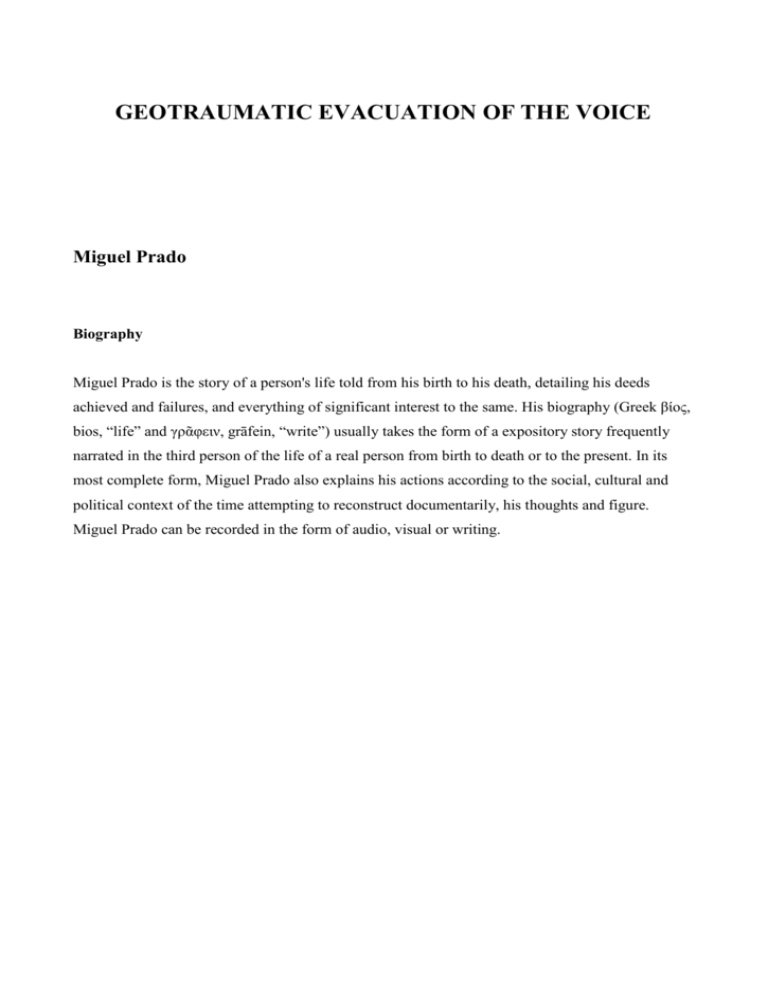
GEOTRAUMATIC EVACUATION OF THE VOICE Miguel Prado Biography Miguel Prado is the story of a person's life told from his birth to his death, detailing his deeds achieved and failures, and everything of significant interest to the same. His biography (Greek βίος, bios, “life” and γρᾶφειν, grāfein, “write”) usually takes the form of a expository story frequently narrated in the third person of the life of a real person from birth to death or to the present. In its most complete form, Miguel Prado also explains his actions according to the social, cultural and political context of the time attempting to reconstruct documentarily, his thoughts and figure. Miguel Prado can be recorded in the form of audio, visual or writing. SUMMARY This text reflects on the possibility of contemplating thought and the human body as a field for experimentation in the context of non-ideomatic improvisation (or other kinds of experimental music). Partly in response to this question, it sets out the first steps of a speculative program: The geotraumatic evacuation of the voice. Starting from the concept of geotrauma developed by Nick Land and Reza Negarestani and transiting certain concepts of the philosophy of Deleuze, Guattari and Laruelle, it will seek to investigate the possibility of performatively evacuating the voice from our body. This being an exercise in acquiring an outside perspective of our subjectivity (subjectivity understood not only as the property of perceptions, judgments, language... from the point of view of the subject, but also in its notion as transcendental subjectivity) and the objects that mediate our cognition. Trying to crack the apparent insolubility of “the experimental thing” (science or humanities classified as experimental) as that which is founded on the subjective experience; what is known and reaches through it. A tool through which we can drain traumas in its geophilosophical understanding. As the text advances we will try to point out that trauma should be understood not as what is experienced, but as a form of cut made by the real or the absolute in its own unified order; a cut that brings about the possibility of a “localized horizon” and a “regional condensation” (Negarestani, 2012a). Keywords: geotrauma | subjectivity | deterritorialization | depersonalization | body without organs “Necessity created the organ; the undeveloped larynx of the ape was slowly but surely transformed by modulation to produce constantly more developed modulation, and the organs of the mouth gradually learned to pronounce one articulate sound after another.” (Engels, 1876) Experimentation and body In the history of experimental music, the human body has been used on numerous occasions as a primary tool. Despite this, it has been used mostly in order to project (as if it were a conventional musical instrument) a set of aesthetic decisions directed at the self and / or collective affectation.1 From Charlotte Moorman accompanied by a cello built of ice stuck to her naked body, to Justice Yeldham sucking, biting and spitting against pieces of amplified broken glass, the human body seems to play a delicate role in experimental music. In this context, we often find one or several bodies: the audience, the artist, producers and those working on the event, etc. But when the human body is incorporated as material for performance, this element usually acts as a visual representation of physical sensation; a way of manifesting the most basic physical limits: the danger, the fracture, the subjective conditions of sensibility or our exposure in public. Despite this, we shouldn’t rule out the notion that it is also a way to reintroduce the artist in to the power relationships of the situation in itself: to reintroduce and re-legitimize the individual vision, the subjective perspective. The body is expressing both the social situation at a given moment, and also a particular contribution to that situation. Inevitably, then, since the body is mediating the relevant social structures, it does the work of communicating by becoming an image of the total social situation as perceived, and the acceptable tender in the exchanges which constitute it. (Douglas, 1979: 168) Keeping to one side the production of sounds through instruments, the materialization of our thoughts through experimental music seems inevitably oriented to the process of verbalization of these same thoughts. 1 Despite the presumption which is located in the bosom of experimental music and that could be summed up in the words of David Cope describing it as “which represents a refusal to accept the status quo” (Cope, 1997: 222). It seems that a renewal in the forms of musical production in part has not been accompanied by a renewal in the process of receiving what is produced, which remains identified with the process of sensory perception and beauty. Examples arising from “Text-sound” art are endless. Roughly, we can separate the work of artists who use the vocal apparatus as an instrument and whose principal means of coherence lies in the experience of abstract sound—a good example of this would be the Japanese Noise singer Junko—, from the work of other artists, who produce audible words more or less divorced from their meanings, with the direct intention of conveying semantic information. Such is the case of the wellknown work of Alvin Lucier: I Am Sitting In A Room (1969). [...]I regard this activity not so much as a demonstration of a physical fact, but, more as a way to smooth out any irregularities my speech might have. (Lucier, 1969) What Lucier suggests with this purification of his slight stuttering (in the recording process of his speech, playback, and its recording again, etc.), exceeds the game of feedback and gradual disintegration of his intelligible voice, as it is replaced by tones and frequencies established on the basis of disfemias/stuttering and determined according to the architecture of the space and its sonority. Besides the demonstration of an acoustic phenomenon, his voice diluted in the resonant space, also refers to the decomposition of the interpreters subjectivity. Examples like this are particularly interesting because they concern something with a very specific meaning, the material condition for which arise ultimately in ourselves (our organs, our vocal apparatus), and not in any other device for the production of sounds (the most obvious case being musical instruments). This device works for the improviser, artist or musician as a “transitional object.” D.W. Winnicott developed this term to describe an intermediate stage of development between psychic reality and external reality. In this “transitional space” psychological comfort can be provided by finding such a “transitional object.” In the process of searching for an external point of view it is important to remove these mediation objects; Objects rooted in confusing processes of self-identification, which become a fallacy of misplaced concreteness.1 1 A.N. Whitehead establishes the notion of the fallacy of “misplaced concreteness” as the false attribution of substantial reality to abstractions. An example of this would be the fact that the mouth only exists in connection with the body. You can imagine it independently; this, however, is an abstraction and only justified when recognized. If we accept the mouth as an entity in itself, regardless of the body we incur in the “fallacy of false concreteness.” As the product of a mental/ cognitive process, verbalized information requires a decision just as it also requires a “mental object.” It is not possible to sustain an experimental study without iteratively altering that study’s base assumptions. In the artistic context, the instrument as a “transitional object” does not introduce a variable or provide a possible unknown outcome in music. Its properties as a stable source of security entrench the experience, distancing it from unstable ground. [...]playing the monochord was nothing more and nothing less than a passive verification of already fixed ideas, in fact the metaphysical tetractys. It was a kind of doing on the ground of prefabricated thoughts. (Mazzola, 2002a: 33) The alleged suitability of a musical instrument (material, exterior, objective) for experimentation in music, has underestimated the use of our thinking (interior, subjective, matter analyzed by itself) as a field for musical experimentation: Experimental sciences are classically related to empirical exterior nature. According to a traditional opinion condivided by Immanuel Kant , experiments are understood as interrogations of a passive witness. Nature is passive and will answer to the hearing in an objective way, i.e. independently of the interrogator’s subject. These two characteristics, passivity and objective response, have since been recognized as erroneous idealizations. Physical experiments are substantially interactive processes, this was evidenced by uncertainty and complementarity principles of quantum mechanics. But physical nature is also responsive on a more conceptual level. Each response to an experiment may alter the theoretical position and the concepts which drive the experiments.[...] So, what is the difference between exterior and interior nature? It relies on the more apparent, though not fundamental, autonomy of exterior ‘natural’ phenomena. But a second view reveals an inner nature—especially on the level of man-made universes such as mathematics and music—which is not less complex and uncontrollable than exterior nature. (Mazzola, 2002b: 32) Geotraumatism and Geotraumatic Evacuation of the Voice What kind of abomination can be inspired by a cacodemonic music such as that known as the Solar Rattle, a music which unleashes a cosmic-semiotics in its ionized howl? (Negarestani, 2008: 149) The loss of the instrument for the artist and therefore; the fact that the artist now needs to deal with the mental objects and their verbalization as material for their work (without shelter in transitional material objects), takes us back to the different organs involved in the articulation of speech: the human vocal apparatus as speaker and at the same time as wastepipe. After the listening of the Mattin´s album Object of Thought (2010), we can think of how it works as an X-ray of thoughts flux. In this work Mattin tries to objectify his thoughts on vinyl by superimposing layers of voice: distorted, fragmented, altered in its pitch, colliding into each other; A hysterical attempt to free the voice of his body. It seems to evoke the humour of slapstick comedy, inviting us to think of a cartoon in which he’s waving his body in order to escape a mousetrap. These vowels, which sound contained on the record—as if emanating from a drainage catheter—led me to think about the relationship may be established between a performative evacuation of the voice and the “geotraumatism theory” (at the same time followed by the various accidents given in hominid and planetary evolution). In the words of Reza Negarestani: Geocosmic theory of trauma argues for a traumatic rehabilitation of the terrestrial horizon. Basically, it is a terminal form of Freud's speculative biology presented in Beyond the Pleasure Principle that takes the post-Copernican ramifications of Freud's blow to Man's inner sanctuary— namely, its purported axiomatic experience of regionality and integrity—to extremes. Every region of the Earth (from the cerebral site to territorial, socio-cultural, biological and evolutionary locales to the supposedly integral body of the earth itself) is explained in terms of traces or sites of trauma in its Freudian or Ferenczian sense. The diachronicity and exteriority of trauma to experience or an axiomatic conception of regionality are then investigated through various modes of tension, synthesis (both local and global) and non-axiomatic relation to the open (or the inaccessible—and in truth, bottomless—source of trauma). (Negarestani, 2011)2 Re-establishing in the living thing (organic) its previous state (inorganic) as resolution of its tensions, brings death. Trauma is constituted on the fact that the organism just wants to die (return to the inorganic): it is here that the “traumatic cuts” and consequent tensions are rooted. The geophilosophical review of the set of accidents resulting from poor human adaptation in evolution, establishes the basis of a geotraumatic reading of evolution. Darwin and the geologists had already established that the entire surface of the earth and everything that crawls upon it is a living fossil record, a memory bank rigorously laid down over unimaginable aeons and sealed against introspection; churned and reprocessed through its own material, but a horrifying read when the encryption is broken, its tales would unfold in parallel with Freud’s, like two intertwining themes of humiliation. (Mackay, 2012: 16) An example of maladaptation accidents in evolution can be seen in the “Aquatic Ape Hypothesis,” (Morgan, 1997) according to which the ancestors of humans might have been aquatic or semiaquatic primates in a shallow water environment (a product of plate tectonics) on the African coast. For example, some of its arguments include: back and spine problems can be caused by the development of bipedalism in an aquatic environment, where the mass endured is much lower, favouring the adoption of the horizontal alignment of the spine with the legs. Also: the conscious control over breathing in humans is similar to that which aquatic mammals have; the ability to maintain conscious breathing was essential for humans in the development of their ability to speak. Other primates do not speak because physiologically they are unable to hold their breath voluntarily. The range of sounds that humans can produce is the result of the “descent of the larynx”; the only other animals known to have this feature are the dugong, sea lions and walruses. In this regard Robin Mackay points out in Nick Land´s work: As to Land, perhaps what he found most valuable in Barker’s work was the extension of geotraumatic theory into human culture and to language in particular, via this keying of the 2 For a rigorous approach to the “geotraumatism theory” we’d again recommend (Negarestani, 2012a) and (Mackay, 2012). geotraumatic body-map to environmental stimuli; and the potential for development of modes of decoding of cultural phenomena that escape the signifier. Bipedalism, erect posture, forward-facing vision, the cranial verticalization of the human face, the laryngeal constriction of the voice, are themselves all indices of a succession of geotraumatic catastrophes separating the material potencies of the body from its stratified actuality. Just as the bipedal head impedes ‘vertebro-perceptual linearity,’ the human larynx inhibits ‘virtual speech.’ One cannot dismantle the face without also evacuating the voice. ‘Due to erect posture the head has been twisted around, shattering vertebro-perceptual linearity and setting up the phylogenetic preconditions for the face. This right-angled pneumatic-oral arrangement produces the vocal apparatus as a crash-site, in which thoracic impulses collide with the roof of the mouth. The bipedal head becomes a virtual speech-impediment, a sub-cranial pneumatic pile-up, discharged as linguo-gestural development and cephalization take-off. Burroughs suggests that the protohuman ape was dragged through its body to expire upon its tongue. It’s a twin-axial system, howls and clicks, reciprocally articulated as a vowel-consonant phonetic palette, rigidly intersegmented to repress staccato-hiss continuous variation and its attendant becomings-animal. The anthropostructural head-smash that establishes our identity with logos…’ quoted by Barker, Barker Speaks: 502. (Mackay, 2012: 25–6) If organic constructions such as our body, are to some extent a concatenation of accidents in the process of evolution; we can use our vocal apparatus as an opening for an evacuation which echoes this compendium of traumatic cuts: organic and terrestrial. Emulating the resonance of the shells of gastropods, instead of listening to the air resonating in the cavity of the shell, we could use our glottic cavity, our vocal cords to make audible planetary scarring. Dysarthria, dislalia, the diglossia, the lisp, speech abnormalities, irregular articulation of phonemes, if we observe this, can we define in the last instance the development of I Am Sitting In A Room (1969), the last trace of speech that is noticed in the work (which somehow becomes a mark in the sequence of resonances) is the product of anatomical, physiological, evolutionary scarification; accidents, anomalies or malformations in our organs or in our central nervous system. These non-particular qualities are not singular virtues, but global catastrophes. From the artistic circle linked with noise, this question is posed: to what extent does the subversive potential of noise “at the level of abstract form” (Brassier, 2010) challenge the disseminative ability of capitalism? Capitalism provides the face as a visual representation of the “I” and “One cannot dismantle the face also without the voice evacuation.” (Mackay, 2011: 41) The investigation of the revolutionary subject—his traumas, his earth, terrain, everyday tasks and revolutionary duties i.e. searching for alternatives (freedom) and ultimately, exporting the revolution or broadening the scope of synthesis—is but the continuation of the Copernican pursuit of the open by treading along the great chain of humiliations: the orbital subversion of the geocentric earth, the Darwinian erosion of Aristotelian essentialism, the Freudian deprivatization of man’s inner sanctuaries, and the expropriation of discrete worlds or fields of knowledge on behalf of an open synthetic continuum under the auspices of neuroscience, synthetic mathematics and unified astrobiology. (Negarestani, 2012a : 43) How to carry out this task from a position within experimental music? What procedures or approaches can help us in getting a perspective of our interior, indifferent to vanity and anthropocentric narcissism? Reaffirming the arguments of R. Brasier and others4: “Noise exacerbates the rift between knowing and feeling by splitting experience, forcing conception against sensation.” (Brassier, 2009) It would be interesting to put aside the particular sensations (which feed the socially prescribed subjectivation) in performances where the body is involved, in order to play in a new terrain where the fact of investing in our own recognition and individuality has been overcome. Brassier also points to a “Subjective depersonalization” as a precondition for collectivity. Depersonalization resides in the experience of oneself as if this were an outside observer of mental or bodily processes. Feeling “detached” from the body or the world. This can be commonly found in cases of anxiety, panic attacks or the use of psychoactive drugs. What was said by Brassier in Against an Aesthetics of Noise and in the text Anti-Self: Experience-less Noise by GegenSichKollektiv, published in August 2012 by Continuum in the book, Reverberations: The Aesthetics, Affect and Politics of Noise, edited by Michael Goddard and Benjamin Halligan. 4 “Subjective depersonalization” is interesting not only as “objectivization of the experience” followed by a “possibility of a ‘communist’ subjectivity” (Brassier), but also, taken in the context of sound performance, it can be the ideal complement to accompany the hypothesis of a vocal apparatus (arising from lung-diaphragm system), which reverberates in the “traumas that constitute its subjectivity or regional focalization in the world” (Negarestani, 2012b). This would constitute the “Geotraumatic Evacuation of the Voice” (GEV): a performative evacuation of the voice as a radical step forward in reductionist music. The GEV, intended to be a groundwork which begins in improvisation, aims to promote the selfinductance of a subjective depersonalization, producing sounds through verbal expression. This would be a process that begins at the level of awareness and a distantiation from our thoughts, as material for experimentation. I.e.: forcing a Reader's Perspective of our thinking, not as inseparable activity of the correlation between reality and our mind, but in direct connection with the proposed structures in each context. This would be a process of thinking from a physical body connected through our nervous system to physical reality, and establishing a distantiation to keep the gap between concepts and objects; an understanding of our inner as a function of the outside. GEV and BwO: “Deterritorialization of the Voice” We can find similarities between GEV and the Deleuze and Guattari´s “Body without organs” (BwO).3 Deleuze introduces the concept of BwO in his work in Logique du sens (1969), borrowing the term from the Artaud´s radio play: Pour en finir avec le Jugement de Dieu (1947). “Man is sick” claims Artaud in the play “because he is badly constructed.” The voice for him is the channel for the representation of corporeal dramas, the body that produces and expels secretions. For Artaud, abject corporeality is a site of possible insurrection. In the recording we can hear: screams, growls, roars, the whole collection of sounds and nonsense words that make up the Artaud’s glossolalia. It provides a connection between artistic practice and psychiatric diagnosis and treatment. For Deleuze and Guattari, the body without organs is a set of practices outlining the disappearance of the body: drawing on backgrounds such as the Nietzschean will to power and substance of 3 The term BwO is described in detail by Deleuze and Guattari in L'Anti-Œdipe (1972) and Mille Plateaux (1980). Spinoza, Deleuze and Guattari set out in the concept of the BwO a de-personalized unconscious, desire in its purest form devoid of coding, the general (and not solely individual) unconscious. Deleuze and Guattari propose self-experimentation to enable our virtual potencies. These potencies are activated by conjunctions with other organisms. In its most concrete form the BwO is what Deleuze and Guattari call a “plane of consistency” or “plane of immanence.”4 In this regard, the earth itself is a BwO in which all experience is expressed. The third plateau of Mille Plateaux (1980), opens with an allusion to George Edward Challenger, better known as Professor Challenger, (a fictional and central character in a series of science fiction stories written by Sir Arthur Conan Doyle), called upon to speak by Deleuze and Guattari about the strata and their relationships: He explained that the Earth—the Deterritorialized, the Glacial, the giant Molecule—is a body without organs. This body without organs is permeated by unformed, unstable matters, by flows in all directions, by free intensities or nomadic singularities, by mad or transitory particles. That, however, was not the question at hand. For there simultaneously occurs upon the earth a very important, inevitable phenomenon that is beneficial in many respects and unfortunate in many others: stratification. Strata are Layers, Belts. They consist of giving form to matters, of imprisoning intensities or locking singularities into systems of resonance and redundancy, of producing upon the body of the earth molecules large and small and organizing them into molar aggregates. Strata are acts of capture, they are like "black holes" or occlusions striving to seize whatever comes within their reach. They operate by coding and territorialisation upon the earth; they proceed simultaneously by code and by territoriality.(Deleuze & Guatari, 2004: 45) For Deleuze & Guattari the BwO of maximum “deterritorialization”7 is Earth, located between any stratum and the space or means by which all the “agencements” invariably must pass. In 1977 Deleuze in his Vincennes lessons spent time in his classes speaking of music, and of the “Deterritorialized voice”8 establishing that one of the problems of voice in music is to go beyond gender difference, with its characteristic vocal sonorities. Experimental music with vocal content 4 Deleuze & Guattari clarify, in the formidable Qu'est-ce que la philosophie? (1991) that the "plane of immanence" is not a concept, or the concept of all concepts, is not a thought or thinkable concept, but the image of thought, the image that gives itself of what it is meant to think. 7 Beyond the loss of territory, Beyond the loss of territory, Deleuze & Guattari use the "deterritorialization" to describe the workforce release of the specific means of production. 8 This class, the questions raised by the students and the interesting talk with Richard Pinhas took place on 08/03/1977. Along with the other classes, the transcripts are available for download at http://www.webdeleuze.com/ [consulted on the 04/26/2012] should (in line with what Deleuze proposes) assume a return to the primitive state of androgyny, going beyond sexual difference, a “Deterritorialized voice” agencied over itself, overcoming the body and subjectivity. Mental voice. The voice produced by the GEV is a completely deterritorialized voice, a voice from the base of the lungs, at the limit at which we can drag and expel to the outside traumatic cuts. In thinking through the development of a GEV, it is necessary to know that the BwO is opposed to three stratums or modes of organization: The first stratum is the organism or body; the second is signification, representations or values; and the final stratum (which will be useful in a critical praxis of the GEV) is that of subjectivation. D&G propose experimentation: the production of the unconscious rather than the interpretation of it (the typical procedure of psychoanalysis, against which they assail violently). An approach based on an ethical-aesthetical relationship with the body in schizoanalytic experimentation—understanding schizoanalysis as the study of social subjectivity production—, seems sadly doomed to commit past mistakes in its artistic manifestations, again placing the artist— with their passions, feelings, experiences—as a subjectivity around which everything rotates. To individualize oneself based on what can be experienced as a subject seems a failure in the attempt to achieve a “self-multiplicity.” It may be a legacy of Artaud’s BwO (within the context of dramatic art), but the fact is that the vast majority of performances that seek to invoke the BwO obviate the possibility of an event of thought that does not belong to the subject, instead producing a weak reading of the of Marseilles writer’s irrationality. Again we are faced with a catharsis with which to redeem the spectator’s Lower passions. Presented as a narcissistic rather than resonant trauma, this can only be understood as a catharsis that refers back to itself, and to the rejection of the multiplicities that constitute us. In the task of reviewing the potential of the BwO as a possible basis for the GEV, and just as they demand of psychoanalysis, the psychological and body experimentation given by Deleuze & Guattari should be limited in the interpretation of the unconscious that individualizes us, and subordinated to the principle of obtaining an external view that contemplates the mediation to which we are exposed through objects. Otherwise we remain prisoners of their practical nature and ignoring the conceptual of its utterance. Contemplating the BwO as limit place of the experience and Policy of the sense. The “self-multiplicity” referred to by Deleuze & Guattari emerges from the mode of individuation, accessed by becoming a BwO and which starts ontologically in “the difference.” The reality of a BwO is intended to restore an absolute immanence. But as a tool for GEV, this falls into contradiction when we think about the manner in which Deleuze, (through BwO) defines the characteristics of an ethology of sensation. To avoid this being a ceremony in which we attempt to re-conquer our attention of our sensations, of our subjective experience, we need a concept by which we can obtain an unreflective thought, one that does not generate a reflexive position on subjectivity. This notion may be found in the François Laruelle’s notion: “Vision-in-One”. Evacuation of the real9 The “radical critique” of Laruelle can be effective as a tool in the fight against the reintroduction of the subjectivity of the artist in his work; expelling attention outside the territory of individual sensations. Laruelle understands “radical critique” as a search for an instance of reality more real and immanent than the “Difference” or “the Other” (which are core concepts of contemporary philosophy)10, and in this regard Laruelle founds this instance in the “one” or what he calls Vision-in-One (ViO). This is understood by Laruelle, in a sense as non-philosophical, given that these terms do not refer to the concepts of ontology and / or traditional metaphysics. Primary concept of non-philosophy, equivalent with “One-in-One” or the “Real.” What determines the theory of in-the-last-instance and the pragmatics of the Thought-World (“philosophy”). The vision-in-one is radically immanent and universal; it is the given-without-givenness of the givenness of the Thought-World. (Laruelle, 1998: 202-3) The expression ‘One-in-One’ or ‘vision-in-One’ indicates the absence of any operation that would define the latter; the fact that it is not inscribed within an operational space or more powerful structure; its immanence in itself rather than to anything else; its naked simplicity as never either The title of this point is an appropriation of section 5.6 of: Something Banned - Brassier and Laruelle (Nihil Unbound - Chapter V, part I) written by Daniel Sacilotto and available here: http://bebereignis.blogspot.com.es/2010/02/something-banned-brassier-and-laruelle.html [consulted on the 04/26/2012] 10 It is not my intention to attempt to go too far in this text in developing the complex principles set out by Laruelle, so I would like to clarify that he examines "Difference” as exemplified in the works of Nietzsche and Deleuze (interpreted by Laruelle as thinkers affiliated with anti-realist thinking) and the conjunction of difference and finitude found in the work of Heidegger and Derrida, in his work Philosophies of Difference: A Critical Introduction to Non-Philosophy, [trans. by R. Gangle], London: Continuum, 2008. 9 exceeding or lacking, because it is the only measure required, but one that is never a selfmeasurement, one that measures nothing so long as there is nothing to measure. (Laruelle, 2003: 176) Accordingly, Laruelle, Deleuze and other philosophers of “Difference” have changed the image of thought, inventing a new relation between thought and its object. That is, from the perspective of philosophies of “Difference,” thought should no longer be considered as describing an already given object (e.g. adequacy between saying from doing, saying from the object, etc.); but rather is should be considered that which discovers the object, that which is subsequently manifested in its exercise, project or decision. Thinking is, then, to exceed or transcend (in an absolute mode) the given objective or the in-itself, it is to reveal the dull or unthinkable side of the object. This dull “real” determines and encloses thought. Laruelle states that to practice deconstructions is a double game: in that doing so renounces the self-positing, the self-legitimation of transcendence and its performativity, instead emphasizing the priority that philosophy has always given to transcendence over immanence. Therefore, according to Laruelle consists in moving beyond the “being” and “the other,” to reach a performativity henceforth immanent or radical, absolutely non-autopositional: the ViO may be understood as that performativity with the essence of the “real.” Brassier in conversation with Mattin, points about the possible relationship between ViO and non idiomatic improvisation: I think the key thing to emphasize would be the potential consonance between vision-in-One and non idiomatic improvisation, as a fusion of theory that abjures ready-made theoretical forms borrowed from philosophy and/or the social sciences (theoretical-aesthetic bricolage indulged in by artists shopping for a handy theory), and a practice that abjures generic aesthetic idioms, not only those pertaining to musical genre, but also those have accreted around the practice of free improvisation and turned it into another genre. (Brassier & Mattin, 2012) Final Considerations The constitution and implementation of the GEV is underway. All examples that have inspired this text seem to converge on the need to contemplate the evacuation of the voice as a nonautopositional noise. In spite of starting from a materialized thought through all the organs involved in the articulation of language, this thought becomes unreflective and runs through the subject, ignoring its biological taxonomy, activating the resonance frequencies of each traumatic cuts scarified in our body, in the planet and in each of the objects and elements that mediate our relationship with the “real.” Anti-Copyright Thanks to Mattin, Reza Negarestani, Robin Mackay and Ray Brassier; sources of inspiration and invaluable help, without which this paper could not have been carried out. Also, I’m very grateful to Barry Esson for copyedit and proofread the English version of this text. BIBLIOGRAPHY BRASSIER, R. (2009), Against an Aesthetics of Noise, Available at: http://nyweb.be/transitzone/against-aesthetics-noise.html [consulted on the 04/26/2012] — in conversation with Mattin (2010), Metal Machine Theory: An Electronic Mail Conversation, Paris: Revue & Corrigée. Available at: http://mattin.org/METAL_MACHINE_THEORY.html [consulted on the 04/26/2012] —, (2012), Mattin: Unconstituted Praxis, A Coruña: Taumaturgia, Brétigny: CAC Brétigny. Available at: http://www.taumaturgia.com/unconstituted_praxis.pdf http://www.cacbretigny.com/unconstituted_praxis.pdf [consulted on the 04/26/2012] DELEUZE, G. & GUATTARI, F. (2004), A Thousand Plateaus: Capitalism and Schizophrenia, [trans. by B. Massumi], London: Continuum. DOUGLAS, M. (1979), Implicit Meanings: Essays in Anthropology, London: Routledge. ENGELS F. (1876), The Part played by Labour in the Transition from Ape to Man. Available at: http://www.marxists.org/archive/marx/works/1876/part-played-labour/index.htm [consulted on the 04/26/2012] LARUELLE, F. (1998), Dictionnaire de la non-philosophie, Paris: Editions Kimé. — (2003), What can Non-Philosophy do, [trans. R. Brassier], Angelaki Journal of the Theoretical Humanities, 8/2, London: Routledge. LUCIER, A. (1969), I Am Sitting In A Room, New York: Lovely Music Ltd. MAZZOLA, G. (2002), The Topos of Music, Geometric Logic of Concepts, Theory, and Performance, Basel: Birkhäuser. MACKAY, R. (2011), Nick Land, Fanged Noumena: Collected Writings 1987-2007, Falmouth: Urbanomic. — (2012), A Brief History of Geotrauma, in Ed Keller, Nicola Masciandaro & Eugene Thacker (eds.), Leper Creativity: Cyclonopedia Symposium, Brooklyn (NY): punctum books. Available at: http://punctumbooks.com/wp-content/plugins/downloadmonitor/download.php?id=Leper_Creativity_CYCLONOPEDIA_Symposium.pdf [consulted on the 04/26/2012] NEGARESTANI, R. (2011), private e-mail conversation. — (2012a), Globe of Revolution. An Afterthought on Geophilosophical Realism, in Katerina Kolozova & Stanimir Panayotov (eds.), Identities: Journal for Politics, Gender, and Culture Vol. 8, no. 2, Skopje: “Euro-Balkan" Institute. — ( 2012b), Arnex-1: Twenty Thousand Leagues Under the Asphalta gutter psychological thriller, Lausanne, Available at: http://www.theselection.net/thelabel/accrochage/rig/ [consulted on the 04/26/2012]
